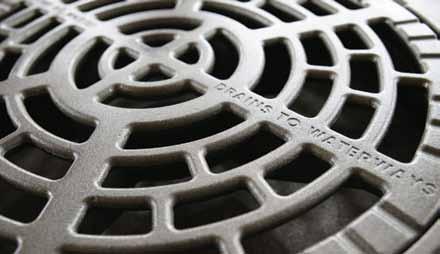
8 minute read
Washington Insight
Jim Fahey
Advertisement
Director of Government and Public Affairs American Public Works Association Washington, D.C.
conference committee to negotiate a House-Senate agreement on a long-term surface transportation reauthorization bill met for the first time in May, more than two and a half years after the last authorization, SAFETEA-LU, expired. The conference committee was established after the House of Representatives in April approved a 90-day extension of the expired law as a vehicle, a shell bill, to convene bicameral negotiations.
Progress toward convening a conference committee and end the stalled process began to gain momentum when in March the Senate approved a two-year, $109 billion reauthorization bill, Moving Ahead for Progress in the 21st Century, by a vote of 74-22. The measure stands as the only comprehensive reauthorization bill approved by either chamber and is the focal point of conference negotiations. Better known by its short name, MAP-21, the bill reauthorizes federal highway and transit programs at current funding levels plus inflation and contains a number of budgetary offsets and transfers necessary to close a $12 billion revenue gap to pay for its funding levels.
MAP-21 makes a number of changes to current programs and policies. It consolidates the number of federal programs from about 90 to less than 30, contains no earmarks, includes new provisions aimed at expediting project delivery and strengthens the Transportation Infrastructure Finance and Innovation Act (TIFIA) program. An amendment added during Finance Committee consideration provides for a five-year exemption from the state private activity bond (PAB) volume cap for water and wastewater projects and provides for a one-year AMT extension for tax-exempt bonds.
MAP-21 provides the majority of highway funds through core programs but reduces the number from seven to five. Three new core programs are established. The National Highway Performance Program consolidates the Interstate Maintenance, National Highway System and Highway Bridge programs to create a single new program. Although the Bridge program was eliminated, the Senate amended the bill to retain the SAFETEA-LU provision in law for more than 30 years that states obligate for offsystem bridges 15 percent of funds apportioned for the highway bridge program in 2009.
The Transportation Mobility Program, the second new core program, replaces the current Surface Transportation Program, but retains the same structure, goals and flexibility. Activities that previously received dedicated funding in SAFETEA-LU but consolidated under MAP-21 are retained as eligible activities. The third core program, the National Freight Network Program, consolidates existing programs into a new focused freight program providing funds by formula for projects to improve regional and national freight movements on highways, including freight intermodal connectors.
MAP-21 retains two existing core programs, the Congestion Mitigation and Air Quality Improvement Program (CMAQ) and the Highway Safety Improvement Program (HSIP). CMAQ provides funds for transportation projects designed to reduce traffic congestion and improve air quality. The bill was amended during floor debate to give local governments access to its “Additional Activities” program, which consolidated Transportation Enhancement, Recreational Trails and Safe Routes to Schools programs under CMAQ. Under HSIP, MAP21 doubles funding for safety and requires states to develop and implement safety plans. The High Risk Rural Road program setaside is eliminated but project eligibilities are retained.
The legislation includes a number of reforms intended to reduce project delivery time and cost. These reforms include expanding the use of innovative contracting methods; creating dispute resolution procedures; allowing for early rightof-way acquisitions; reducing hurdles for projects with no significant environmental impact; encouraging early coordination between relevant agencies to avoid delays later in the review process; and accelerating project delivery decisions.
MAP-21 authorizes $1 billion in fiscal year 2013 to fund major projects of national and regional
significance and $1 billion for TIFIA, which provides direct loans, loan guarantees and lines of credit to surface transportation projects. The legislation also establishes an outcome-driven approach that tracks performance.
Although the House did not pass a comprehensive bill, the House Transportation and Infrastructure (T&I) Committee did, the American Energy and Infrastructure Jobs Act, a five-year, $260 billion measure which was to be combined into one package with several bills to expand energy production to help pay for its costs. Like MAP-21, the House bill consolidates numerous programs, contains no earmarks and includes provisions to expedite project delivery. House leaders say they will negotiate on behalf of priorities reflected in the House T&I Committee bill. In February, House leaders suspended consideration of the House bill before it reached the floor. It lacked the votes needed for passage, in part due to provisions which would have eliminated dedicated funding for transit from the Highway Trust Fund and transit’s share of motor fuel tax revenues. The bill’s cost and offsets also became an issue. The bill was modified and the transit provisions were dropped, but in April plans for floor consideration were abandoned a second time.
With a Senate bill already approved, pressure was growing on Congress to end the series of temporary extensions and complete a reauthorization bill. But with no prospect of bringing a Houseapproved bill to conference, House leaders opted to go to conference on the Senate bill. The House approved the 90-day extension with several policy riders, including a provision approving the Keystone XL pipeline, one creating a trust fund to contribute to Gulf Coast restoration, one increasing funding for port and harbor maintenance, one prohibiting the U.S. Environmental Protection Agency from designating coal ash a hazardous substance and one expediting transportation project delivery, and sent it to the Senate.
The project delivery provisions approved in the 90-day extension bill were those contained in the T&I bill. They allow federal agencies to review transportation projects concurrently, delegate project approval authority to states and establish hard deadlines for federal agencies to make decisions on permits and project approvals. In addition, they call for expanding the list of activities that qualify for categorical exclusions; classifying projects in the right-of-way as
EJ is driven by unparalleled customer care, exceptional solutions, global expertise, and local understanding.
We are EJ.
Learn more at ejco.com or 800 626 4653
East Jordan Iron Works is now EJ
categorical exclusions under NEPA; granting NEPA exemption for certain small projects; allowing acquisition of land during NEPA where the transaction itself does not cause a change in the area’s land use or cause adverse environmental effects; and allowing detailed design prior to NEPA completion at state expense, making such work eligible for federal reimbursement only if the project is subsequently approved.
The House and Senate conference committee’s size, 47 members, reflects the breadth of the policy areas under consideration. Members were appointed from seven congressional committees with jurisdiction over the bill’s various provisions: funding, financing, transit, highways, safety, motor carriers and energy. The Senate named 14 conferees altogether, eight Democrats and six Republicans; the House appointed 33, 20 Republicans and 13 Democrats.
At its first meeting in May, conferees presented opening statements. Sen. Barbara Boxer (D-CA), chair of the Senate Environment and Public Works Committee and chair of the conference committee, attempted to set the tone for the upcoming negotiations by framing the issues in terms of the provisions of MAP-21: highways, bridges, roads and routes; financing; transit and safety. Many conferees made it clear, however, that certain non-MAP-21 issues stood as important priorities for them, including the Keystone pipeline and the coal ash provisions. Statements by other conferees made clear that still other issues, including funding and finance and some provisions to expedite project delivery, divided conferees and loomed as contentious points.
When conferees met that day in May, they faced a June 30 deadline for a bill to be signed into law in order to avoid the need for another extension. Conferees expressed their commitment to achieving an agreement and that they expected they would have one.
FHWA eliminates dozens of deadlines for replacing traffic signs
The Federal Highway Administration (FHWA) issued a final rule effective June 13 eliminating 46 regulations on traffic signs, including allowing communities to replace traffic signs when they are worn out rather than requiring signs to be replaced by a specific date.
The regulations establishing deadlines for street sign replacement came from the Manual on Uniform Traffic Control Devices (MUTCD), which is a compilation of national standards for all pavement markings, street signs and traffic signals. FHWA, which has published the manual since 1971, updates it periodically to accommodate changing transportation needs and address new safety technologies, traffic control tools and traffic management techniques.
In August 2011 FHWA issued a Notice of Proposed Amendments to eliminate the 46 deadlines, and a final rule was published in the May 14 Federal Register. The deadlines requiring certain street-name signs be replaced by 2018 to meet minimum retroreflectivity standards and requiring larger lettering on those street-name signs are among the deadlines eliminated.
The final rule also eliminates deadlines for increasing the size of various traffic signs, such as “Pass with Care” and “Low Clearance.” Instead, communities will be able to replace and upgrade these signs when they reach the end of their useful life. In addition to eliminating the deadlines, FHWA will allow communities to retain historic street-name signs in historic districts.
FHWA has retained 12 deadlines for sign upgrades that are critical to public safety. These safety-critical sign upgrades include installing one-way signs at intersections with divided highways or one-way streets and requiring stop or yield signs to be added at all railroad crossings that do not have train-activated automatic gates or flashing lights.
For more information about the revisions, visit http://mutcd.fhwa.dot. gov/kno_2009r1r2.htm.
Jim Fahey can be reached at (202) 2186730 or jfahey@apwa.net.
“We have to convince our leadership throughout the years that there is a strong business benefit to valuing diversity. They will be attracting the best and brightest employees. We will have better customer relationships over the long term because our employees mirror our customer demographics. As a result, there are bottom-line benefits to our shareholders.” Michael J. Critelli, former Executive Chairman, Pitney Bowes, Inc.








